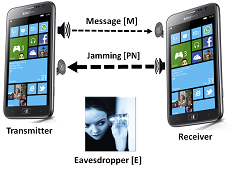 Dhwani enables information theoretically secure Near Field Communication (NFC) on existing mobile phones without requiring any special hardware or PKI infrastructure. It uses existing microphones and speakers on phones to perform acoustic NFC. It uses a novel self-jamming based physical layer security technique called SecureJam.
Dhwani enables information theoretically secure Near Field Communication (NFC) on existing mobile phones without requiring any special hardware or PKI infrastructure. It uses existing microphones and speakers on phones to perform acoustic NFC. It uses a novel self-jamming based physical layer security technique called SecureJam.
-
- Slashdot (opens in new tab)
- Extremetech (opens in new tab)
- Andriod Authority (opens in new tab)
- Computer World (opens in new tab)
- The Register (opens in new tab)
- Techtree (opens in new tab)
- EETIndia (opens in new tab)
- Ubergizmo (opens in new tab)
- 2d-code (opens in new tab)
- Crazy Engineers (opens in new tab)
-

Near-Field Communication (NFC) enables low data rate, bidirectional communication between devices within close proximity, usually within a few centimeters, in a peer-to-peer manner. The key advantage of NFC is that it eliminates the need for cumbersome network configuration efforts required to set up a communication channel using alternatives such as Bluetooth or WiFi. This is due to its inherent property of association by physical proximity – if two devices can communicate using NFC, then it implies that they must be co-located. As an example, using an NFC enabled mobile phone, a user can make payments by simply bringing the phone close to a reader at the checkout counter, without having to first identify the reader or connect to it. Several NFC-based applications have been proposed or demonstrated, e.g., contact-less payment, access control, social networking, ticketing, museum services, etc. In many cases, NFC is used to automatically initiate and set up a high data rate communication channel such as WiFi or Bluetooth.
-
NFC faces two key challenges today,
- Low adoption due to low levels of hardware penetration – 3-5% penetration in phones worldwide today. Only 5% Point of Sale terminals are NFC enabled.
- Lack of security – No security in Phy-Mac layers. NFC is perceived as difficult to intercept due to close range. However, eavesdropping has been demonstrated using off-the-shelf devices from 1 m away.
-
Almost all mobile phones have a speaker and a microphone. Dhwani implements an OFDM based acoustic Software Defined Radio (SDR) to transmit data. Acoustic NFC has to overcome several challenges inherent in the Acoustic domain,
- Frequency selective speaker/microphone characteristics due to electromechanical conversion
- Large multipath or echos
- Ambient noise sources
Dhwani solves these problems in order to make acoustic NFC communication practical.
-
The basic idea of SecureJam is that the transmitter jams the incoming signal by transmitting a Psuedo Noise sequence in such a way that information theoretically, an eavesdropper cannot extract any information from the jammed signal. However, knowing the jamming signal, the receiver can perform self-interference cancelation and subtract the effects of its own jamming signal. Self-interference cancelation is especially difficult in the acoustic domain due to multipath and frequency selectivity. SecureJam leverages a property unique to acoustic communication — the fact that most of the transformation between the transmitted signal and the received signal is in fact due to the static speaker and microphone characteristics.
People
Venkat Padmanabhan
Deputy Managing Director, Microsoft Research India
